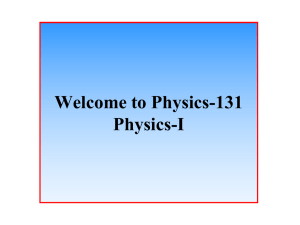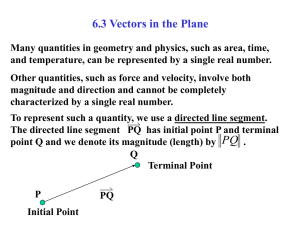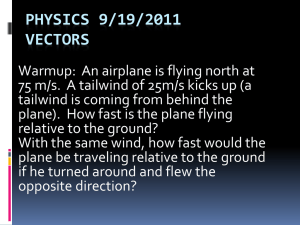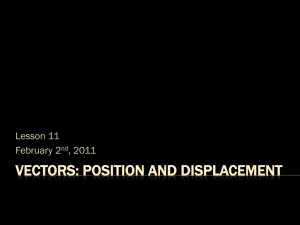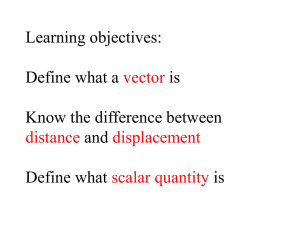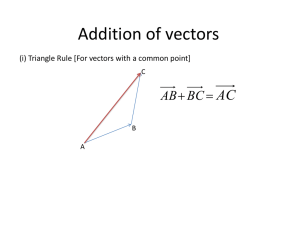Vector Notes
advertisement
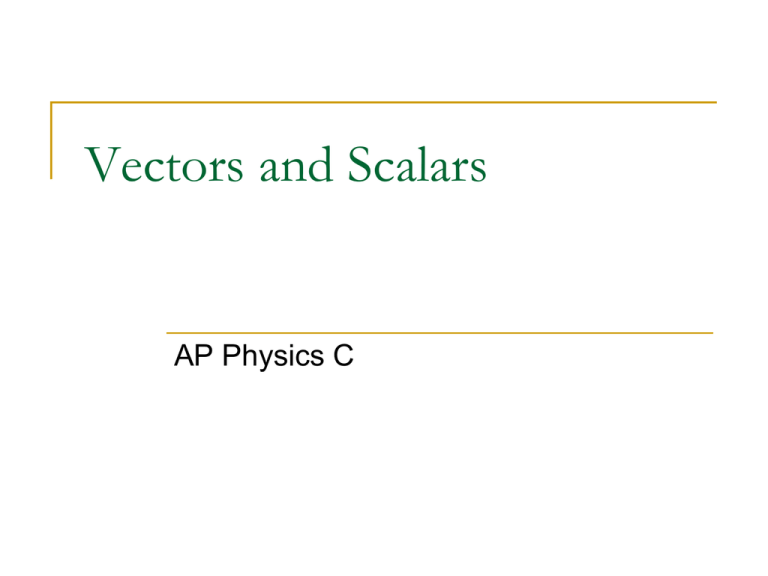
Vectors and Scalars AP Physics C Scalar A SCALAR is ANY quantity in physics that has MAGNITUDE, but NOT a direction associated with it. Magnitude – A numerical value with units. Scalar Example Magnitude Speed 20 m/s Distance 10 m Age 15 years Heat 1000 calories Vector A VECTOR is ANY quantity in physics that has BOTH MAGNITUDE and DIRECTION. v , x, a, F Vectors are typically illustrated by drawing an ARROW above the symbol. The arrow is used to convey direction and magnitude. Vector Velocity Magnitude & Direction 20 m/s, N Acceleration 10 m/s/s, E Force 5 N, West Polar Notation Polar notation defines a vector by designating the vector’s magnitude |A| and angle θ relative to the +x axis. Using that notation the vector is written: In this picture we have a force vector with magnitude 12 Newtons oriented at 210 degrees with the + x axis. It would be characterized as F = 12 < 210 Polar Notation In this picture we have a force vector of 12 Newtons oriented along the -x axis. However, polar notation is relative to the + x axis. Therefore, it would be characterized by F = 12 N < 180 In this last picture we have 2 vectors. They are characterized by: C = 2 N < 30 D = 4 N < - 50 or D = 4 N< 310 Scalar Multiplication Multiplying a vector by “-1” does not change the magnitude, but it does reverse it's direction or in a sense, it's angle. Multiplying a vector by a scalar will ONLY CHANGE its magnitude. Thus if A = 12 < 105, Then 2A = 24 < 105 -1/2A Thus if A = 12 < 105, then -A = 12 < 285 If A = 12 < 105, then (-1/2)A = 6 < 285 Unit Vector Notation An effective and popular system used in engineering is called unit vector notation. It is used to denote vectors with an x-y Cartesian coordinate system. Unit Vector Notation =3j J = vector of magnitude “1” in the “y” direction i = vector of magnitude “1” in the “x” direction = 4i The hypotenuse in Physics is called the RESULTANT or VECTOR SUM. The LEGS of the triangle are called the COMPONENTS A 4 iˆ 3 ˆj 3j 4i Horizontal Component Vertical Component NOTE: When drawing a right triangle that conveys some type of motion, you MUST draw your components HEAD TO TOE. Unit Vector Notation iˆ - unit vecto r 1 in the x direction ˆj - unit vecto r 1 in the y direction kˆ - unit vecto r 1 in the z direction The proper terminology is to use the “hat” instead of the arrow. So we have i-hat, j-hat, and k-hat which are used to describe any type of motion in 3D space. How would you write vectors J and K in unit vector notation? J 2 iˆ 4 ˆj K 2 iˆ 5 ˆj Applications of Vectors VECTOR ADDITION – If 2 similar vectors point in the SAME direction, add them. Example: A man walks 54.5 meters east, then another 30 meters east. Calculate his displacement relative to where he started? 54.5 m, E + 84.5 m, E 30 m, E Notice that the SIZE of the arrow conveys MAGNITUDE and the way it was drawn conveys DIRECTION. Applications of Vectors VECTOR SUBTRACTION - If 2 vectors are going in opposite directions, you SUBTRACT. Example: A man walks 54.5 meters east, then 30 meters west. Calculate his displacement relative to where he started? 54.5 m, E 30 m, W 24.5 m, E - Non-Collinear Vectors When 2 vectors are perpendicular, you must use the Pythagorean theorem. A man walks 95 km, East then 55 km, north. Calculate his RESULTANT DISPLACEMENT. c a b c 2 55 km, N a b 2 c Resultant c 95 km,E 2 2 95 55 2 12050 109 . 8 km 2 2 BUT…..what about the VALUE of the angle??? Just putting North of East on the answer is NOT specific enough for the direction. We MUST find the VALUE of the angle. 109.8 km 55 km, N N of E 95 km,E To find the value of the angle we use a Trig function called TANGENT. Tan opposite side adjacent Tan 1 side ( 0 . 5789 ) 30 55 0 . 5789 95 109 . 8 km @ 30 NofE So the COMPLETE final answer is : 109 . 8 km 30 95 iˆ km 55 ˆj km What if you are missing a component? Suppose a person walked 65 m, 25 degrees East of North. What were his horizontal and vertical components? H.C. = ? V.C = ? 25 65 m The goal: ALWAYS MAKE A RIGHT TRIANGLE! To solve for components, we often use the trig functions sine and cosine. cosine adjacent side hypotenuse adj hyp cos sine opposite side hypotenuse opp hyp sin adj V .C . 65 cos 25 58 . 91 m , N or 58 . 91 ˆj m opp H .C . 65 sin 25 27 . 47 m , E or 27 . 47 iˆ m Example A bear, searching for food wanders 35 meters east then 20 meters north. Frustrated, he wanders another 12 meters west then 6 meters south. Calculate the bear's displacement. - 12 m, W - = 23 m, E = 14 m, N 6 m, S R 20 m, N 14 23 2 Tan 14 2 26 . 93 m . 6087 23 35 m, E 14 m, N R 23 m, E The Final Answer: Tan 1 ( 0 . 6087 ) 31 . 3 26 . 93 m @ 31 . 3 NofE 26 . 93 m 31 . 3 23 iˆ m 14 ˆj m Example A boat moves with a velocity of 15 m/s, N in a river which flows with a velocity of 8.0 m/s, west. Calculate the boat's resultant velocity with respect to due north. Rv 8.0 m/s, W 8 15 Tan Tan 8 2 17 m / s 0 . 5333 15 15 m/s, N Rv 2 1 ( 0 . 5333 ) 28 . 1 17 m / s @ 28 . 1 WofN The Final Answer : 17 m / s 118 . 1 8 iˆ m / s 15 ˆj m / s Example A plane moves with a velocity of 63.5 m/s at 32 degrees South of East. Calculate the plane's horizontal and vertical velocity components. cosine adjacent side hypotenuse adj hyp cos H.C. =? 32 63.5 m/s V.C. = ? sine opposite side hypotenuse opp hyp sin adj H .C . 63 . 5 cos 32 53 . 85 m / s , E or 53 . 85 iˆ opp V .C . 63 . 5 sin 32 33 . 64 m / s , S or 33 . 64 ˆj What if the vectors are not at right angles? A plane is traveling at 150 mph with a heading of 60 N of W. The wind is pushing the plane East at 40 mph. What is the resulting velocity of the plane? The “Dot” Product (Vector Multiplication) Multiplying 2 vectors sometimes gives you a SCALAR quantity which we call the SCALAR DOT PRODUCT. In polar notation consider 2 vectors: A = |A| < θ1 & B = |B| < θ2 The dot product between A and B produces a SCALAR quantity. The magnitude of the scalar product is defined as: Where is the NET angle between the two vectors. As shown in the figure. The Scalar Dot Product Let A = |12| < 30, Let B = |5| < 65 What is A "dot" B? A B A B cos 12 5 cos 35 A B 49 . 15 In unit vector notation, it looks a little different. Consider: The "Dot" product between these is equal to: The Scalar Dot Product What is the SIGNIFICANCE of the dot product? The significance of the dot product In this figure, vector B has been split into 2 components, one PARALLEL to vector A and one PERPENDICULAR to vector A. Notice that the component parallel to vector A has a magnitude of |B|Cos θ THEREFORE when you find the DOT PRODUCT, the result is: i) The MAGNITUDE of one vector, in this case |A| and, ii) The MAGNITUDE of the 2nd vector's component that runs parallel to the first vector. (That is where the cosine comes from) Dot Products in Physics Consider this situation: A force F is applied to a moving object as it transverses over a frictionless surface for a displacement, d. As F is applied to the object it will increase the object's speed! But which part of F really causes the object to increase in speed? It is |F|Cos θ ! Because it is parallel to the displacement d In fact if you apply the dot product, you get (|F|Cos θ)d, which happens to be defined as "WORK" (check your equation sheet!) A B A B cos W F x F x cos Work is a type of energy and energy DOES NOT have a direction, that is why WORK is a scalar or in this case a SCALAR PRODUCT (AKA DOT PRODUCT). Example A particle moving in the xy plane undergoes a displacement given by: r = (2.0i + 3.0j) m as a constant force F=(5.0i+2.0j) N acts on the particle. Calculate the work done on the particle. (16 J) The “Cross” Product (Vector Multiplication) Multiplying 2 vectors sometimes gives you a VECTOR quantity which we call the VECTOR CROSS PRODUCT. In polar notation consider 2 vectors: A = |A| < θ1 & B = |B| < θ2 The cross product between A and B produces a VECTOR quantity. The magnitude of the vector product is defined as: Where is the NET angle between the two vectors. As shown in the figure. B A The Vector Cross Product A B A B A B sin 12 5 sin 150 A B 30 kˆ What about the direction???? Positive k-hat??? We can use what is called the RIGHT HAND THUMB RULE. •Fingers are the first vector, A •Palm is the second vector, B •Thumb is the direction of the cross product. •Cross your fingers, A, towards, B so that they CURL. The direction it moves will be either clockwise (NEGATIVE) or counter clockwise (POSITIVE) In our example, the thumb points OUTWARD which is the Z axis and thus our answer would be 30 k-hat since the curl moves counter clockwise. The significance of the cross product In this figure, vector A has been split into 2 components, one PARALLEL to vector B and one PERPENDICULAR to vector B. Notice that the component perpendicular to vector B has a magnitude of |A|sin θ THEREFORE when you find the CROSS PRODUCT, the result is: i) The MAGNITUDE of one vector, in this case |B| and, ii) The MAGNITUDE of the 2nd vector's component that runs perpendicular to the first vector. ( that is where the sine comes from) Cross Products in Physics There are many cross products in physics. You will see the matrix system when you learn to analyze circuits with multiple batteries. The cross product system will also be used in mechanics (rotation) as well as understanding the behavior of particles in magnetic fields. A force F is applied to a wrench a displacement r from a specific point of rotation (ie. a bolt). Common sense will tell us the larger r is the easier it will be to turn the bolt. But which part of F actually causes the wrench to turn? |F| Sin θ A B A B sin F r F r sin Cross Products in Physics A B A B sin F r F r sin What about the DIRECTION? Which way will the wrench turn? Counter Clockwise Is the turning direction positive or negative? Positive Which way will the BOLT move? IN or OUT of the page? OUT You have to remember that cross products give you a direction on the OTHER axis from the 2 you are crossing. So if “r” is on the x-axis and “F” is on the y-axis, the cross products direction is on the z-axis. In this case, a POSITIVE k-hat. Example A force of F=(2.00i+3.00 j)N is applied to an object that is pivoted about a fixed axis aligned along the z coordinate axis. The force is applied at a point located at r=(4.00i+5.00j) m . Find the torque vector(2.0 k) Nm
